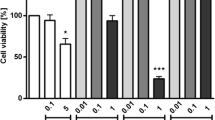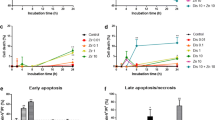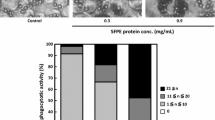Abstract
Phytohemagglutinin (PHA) is a plant mitogen that can agglutinate human leukocytes and erythrocytes. PHA is mainly derived from red kidney beans and can act as an exogenous pyrogen. When entering into the blood circulation, exogenous pyrogens principally interact with monocytes and macrophages and induce the release of pro-inflammatory cytokines. Monocytes and macrophages are the cells that fight against foreign invaders and acts as a primary line of immune defence. Similar to PHA, the chemical 2,4,6-trinitrophenol (TNP) also acts as an exogenous pyrogen. The study focused on the in vitro interaction of PHA and TNP with the human monocyte/macrophage cell model THP-1. The exposure and associated change in cellular morphology, organelle function, mechanism of cell death, inflammatory signalling and expression of inflammation-related genes were analyzed in different time periods. It was observed that PHA and TNP induce dose and time-dependent toxicity to monocytes/macrophages where the mechanism of cell death was different for PHA and TNP. Both PHA and TNP can evoke immune signalling with increased expression of inflammatory genes and associated activation of intracellular signalling cascades.
Graphic abstract








Similar content being viewed by others
Data availability
The authors declared that the research data referred to correctly cited in the manuscript's reference section.
Change history
09 December 2021
A Correction to this paper has been published: https://doi.org/10.1007/s11010-021-04316-w
References
McCullough KC, Summerfield A (2005) Basic concepts of immune response and defense development. ILAR J 46(3):230–240. https://doi.org/10.1093/ilar.46.3.230
Amarante-Mendes GP, Adjemian S, Branco LM, Zanetti LC, Weinlich R, Bortoluci KR (2018) Pattern recognition receptors and the host cell death molecular machinery. Front Immunol 9:1–19. https://doi.org/10.3389/fimmu.2018.02379
Guermonprez P, Valladeau J, Zitvogel L, Théry C, Amigorena S (2002) Antigen presentation and T cell stimulation by dendritic cells. Annu rev immunol 20(1):621–667. https://doi.org/10.1146/annurev.immunol.20.100301.064828
Movafagh A, Heydary H, Mortazavi-Tabatabaei SA, Azargashb E (2011) The significance application of indigenous phytohemagglutinin (PHA) mitogen on metaphase and cell culture procedure. Iran J Pharm Res 10(4):895–903
De Groote D, Zangerlé PF, Gevaert Y, Fassotte MF, Beguin Y, Noizat-Pirenne F, Pirenne J, Gathy R, Lopez M, Dehart I, Igot D (1992) Direct stimulation of cytokines (IL-1β, TNF-α, IL-6, IL-2, IFN-γ and GM-CSF) in whole blood. I. Comparison with isolated PBMC stimulation. Cytokine 4(3):239–248. https://doi.org/10.1016/1043-4666(92)90062-v
Askari VR, Rahimi VB, Zargarani R, Ghodsi R, Boskabady M, Boskabady MH (2020) Anti-oxidant and anti-inflammatory effects of auraptene on phytohemagglutinin (PHA)-induced inflammation in human lymphocytes. Pharmacol Rep 73(1):154–162. https://doi.org/10.1007/s43440-020-00083-5
Kamimaki C, Kobayashi N, Hirata M, Somekawa K, Fukuda N, Kubo S, Katakura S, Teranishi S, Watanabe K, Horita N, Hara Y (2021) T-cell response to phytohemagglutinin in the interferon-γ release assay as a potential biomarker for the response to immune checkpoint inhibitors in patients with non-small cell lung cancer. Thorac Cancer 12(11):1726–1734. https://doi.org/10.1111/1759-7714.13978
Venulet J, Desperak-Naciαzek ANNA (1966) Liver function and pyrexia caused by a pyrogen from Escherichia coli, lysergic acid diethylamide and dinitrophenol. J Pharm Pharmacol 18(1):38–40. https://doi.org/10.1111/j.2042-7158.1966.tb07768.x
Liu S, Wang N, Chen P, Li X, Liu C (2013) Effect of Huanglianjiedu Tang on fever in rats induced by 2,4-dinitrophenol. J Tradit Chin Med 33(4):492–499. https://doi.org/10.1016/s0254-6272(13)60154-5
Mohanan PV, Banerjee S, Geetha CS (2011) Detection of pyrogenicity on medical grade polymer materials using rabbit pyrogen, LAL and ELISA method. J Pharm Biomed Anal 55(5):1170–1174. https://doi.org/10.1016/j.jpba.2011.04.005
Lai W, Guo J, Zheng N, Nie Y, Ye S, Tang D (2020) Selective determination of 2,4,6-trinitrophenol by using a novel carbon nanoparticles as a fluorescent probe in real sample. Anal Bioanal Chem 412(13):3083–3090. https://doi.org/10.1007/s00216-020-02558-z
Borenfreund E, Puerner JA (1985) Toxicity determined in vitro by morphological alterations and neutral red absorption. Toxicol Lett 24(2–3):119–124. https://doi.org/10.1016/0378-4274(85)90046-3
Xu W, Larbi A (2018) Immunity and inflammation: from Jekyll to Hyde. Exp Gerontol 107:98–101. https://doi.org/10.1016/j.exger.2017.11.018
Chen L, Deng H, Cui H, Fang J, Zuo Z, Deng J, Li Y, Wang X, Zhao L (2018) Inflammatory responses and inflammation-associated diseases in organs. Oncotarget 9(6):7204–7218. https://doi.org/10.18632/oncotarget.23208
Ren J, Shi J, Kakuda Y, Kim D, Xue SJ, Zhao M, Jiang Y (2008) Phytohemagglutinin isolectins extracted and purified from red kidney beans and its cytotoxicity on human H9 lymphoma cell line. Sep Purif Technol 63(1):122–128. https://doi.org/10.1016/j.seppur.2008.04.004
Sunderman FW, Weidman FD, Batson OV (1945) Studies of the effects of ammonium picrate on man and certain experimental animals. J Ind Hyg Toxicol 27(9):241–248
Weeks MH, Asaki A, Wade J, Bongiovanni R (1983) Health hazards associated with demilitarization products of ammonium picrate (Explosive D)--In 1983 jannaf safety and environmental protection subcommittee meeting. Army Environmental Hygiene Agency, Aberdeen Proving Ground, MD https://www.dtic.mil/DTICOnline/downloadPdf.search?collectionId=tems&docId=CPIAC-1983-0248M. Accessed Sept 2020
Kuo WT, Ho YJ, Kuo SM, Lin FH, Tsai FJ, Chen YS, Dong GC, Yao CH (2011) Induction of the mitochondria apoptosis pathway by phytohemagglutinin 172 erythroagglutinating in human lung cancer cells. Ann Surg Oncol 18(3):848–856. https://doi.org/10.1245/s10434-010-1351-2
Aits S, Jäättelä M (2013) Lysosomal cell death at a glance. J Cell Sci 126(9):1905–1912. https://doi.org/10.1242/jcs.091181
Signorello MG, Ravera S, Leoncini G (2020) Lectin-induced oxidative stress in human platelets. Redox Biol 32:1–11. https://doi.org/10.1016/j.redox.2020.101456
Karwaciak I, Gorzkiewicz M, Bartosz G, Pulaski L (2017) TLR2 activation induces antioxidant defence in human monocyte-macrophage cell line models. Oncotarget 8(33):54243–54264. https://doi.org/10.18632/oncotarget.17342
Kochubei TO, Maksymchuk OV, Piven OO, Lukash LL (2015) Isolectins of phytohemagglutinin are able to induce apoptosis in HEp-2 carcinoma cells in vitro. Exp Oncol 37(2):116–119
Orrenius S, Nicotera P, Zhivotovsky B (2011) Cell death mechanisms and their implications in toxicology. Toxicol Sci 119(1):3–19. https://doi.org/10.1093/toxsci/kfq268
McConkey DJ, Hartzell P, Duddy SK, Hakansson H, Orrenius S (1988) 2,3,7,8-Tetrachlorodibenzo- p-dioxin kills immature thymocytes by Ca2+-mediated endonuclease activation. Science 242:256–259
Fan J, Nishanian P, Breen EC, McDonald M, Fahey JL (1998) Cytokine gene expression in normal human lymphocytes in response to stimulation. Clin Diagn Lab Immunol 5(3):335–340. https://doi.org/10.1128/CDLI.5.3.335-340.1998
Jeljeli M, Guérin-El Khourouj V, Pédron B, Gressens P, Sibony O, Sterkers G (2019) Ontogeny of cytokine responses to PHA from birth to adulthood. Pediatr Res 86(1):63–70. https://doi.org/10.1038/s41390-019-0383-y
Schroeter CH, Schaub B, Gold DR, Contreras PJ, Manrique O, Gillman MW, Weiss S, Palmer LJ, Perkins D, Finn PW (2004) Nuclear factor kappa B activation in human cord blood mononuclear cells. Pediatr Res 56(2):212–218. https://doi.org/10.1203/01.PDR.0000132850.33375
Seto M (2004) Genetic and epigenetic factors involved in B-cell lymphomagenesis. Cancer Sci 95(9):704–710. https://doi.org/10.1111/j.1349-7006.2004.tb03249.x
Lúdvíksson BR, Ehrhardt RO, Strober W (1997) TGF-beta production regulates the development of the 2,4,6-trinitrophenol-conjugated keyhole limpet hemocyanin-induced colonic inflammation in IL-2-deficient mice. J Immunol 159(7):3622-3628.174
Hu S, Chen CW, Chen ST, Tsui KH, Tang TK, Cheng HT, Hwang GS, Yu JW, Li YC, Wang PS, Wang SW (2019) Inhibitory effect of berberineon interleukin-2 secretion from PHA-treated lymphocytic Jurkat cells. Int Immunopharmacol 66:267–273. https://doi.org/10.1016/j.intimp.2018.11.020
Acknowledgements
The authors wish to express their thanks to the Director and Head, Biomedical Technology Wing, Sree Chitra Tirunal Institute for Medical Sciences and Technology (Govt. of India), Trivandrum, Kerala, India, for their support and for providing the infrastructure to carry out this work. Prajitha thanks the Council of Scientific and Industrial Research, New Delhi, for the SRF Fellowship.
Author information
Authors and Affiliations
Corresponding author
Ethics declarations
Conflict of interest
The authors declare that they have no conflict of interest.
Additional information
Publisher's Note
Springer Nature remains neutral with regard to jurisdictional claims in published maps and institutional affiliations.
Rights and permissions
About this article
Cite this article
Prajitha, N., Mohanan, P.V. Intracellular inflammatory signalling cascades in human monocytic cells on challenge with phytohemagglutinin and 2,4,6-trinitrophenol. Mol Cell Biochem 477, 395–414 (2022). https://doi.org/10.1007/s11010-021-04296-x
Received:
Accepted:
Published:
Issue Date:
DOI: https://doi.org/10.1007/s11010-021-04296-x




